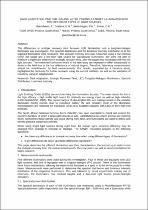 ResearchSpace
ResearchSpace
Dark adaptation time for humans, after viewing a target illuminated with two different types of light sources
JavaScript is disabled for your browser. Some features of this site may not work without it.
- ResearchSpace
- →
- Research Publications/Outputs
- →
- Conference Publications
- →
- View Item
| dc.contributor.author |
Baumbach, J

|
|
| dc.contributor.author |
Coetzee, EM

|
|
| dc.contributor.author |
Sieberhagen, RH

|
|
| dc.contributor.author |
Jonker, CR

|
|
| dc.date.accessioned | 2011-12-13T14:02:20Z | |
| dc.date.available | 2011-12-13T14:02:20Z | |
| dc.date.issued | 2011-07 | |
| dc.identifier.citation | Baumbach, J, Coetzee, EM et al. 2011. Dark adaptation time for humans, after viewing a target illuminated with two different types of light sources. 27th session of the CIE (International Commission on Illumination), Sun City, South Africa, 11-15 July 2011 | en_US |
| dc.identifier.isbn | 9783901906992 | |
| dc.identifier.uri | http://hdl.handle.net/10204/5404 | |
| dc.description | 27th session of the CIE (International Commission on Illumination), Sun City, South Africa, 11-15 July 2011 | en_US |
| dc.description.abstract | The differences in scotopic recovery time between LED illuminators and a tungsten-halogen illuminator was investigated. The spectral distribution and the luminous intensity distribution of all the supplied illuminators were measured. The scotopic recovery time was measured, using a low-contrast USAF bar target and a low-level light source for background illumination. We were not able to measure a significant difference in scotopic recovery time, after the target was illuminated with the two light sources. The measured luminance levels in the laboratory are expected to differ substantially to those in the field due to the low reflectance of natural targets. Therefore, laboratory measurements should be complimented by field measurements. Our results, supported by a literature study, highlighted the necessity for further research using the current methods, as well as the validation of results by using an adaptometer. | en_US |
| dc.language.iso | en | en_US |
| dc.relation.ispartofseries | Workflow request;6808 | |
| dc.subject | Dark adaptation times | en_US |
| dc.subject | Illumination | en_US |
| dc.subject | Scotopic recovery time | en_US |
| dc.subject | Tungsten-Halogen | en_US |
| dc.subject | Spectral distribution | en_US |
| dc.subject | Luminous Intensity | en_US |
| dc.subject | LED illuminators | en_US |
| dc.title | Dark adaptation time for humans, after viewing a target illuminated with two different types of light sources | en_US |
| dc.type | Conference Presentation | en_US |
| dc.identifier.apacitation | Baumbach, J., Coetzee, E., Sieberhagen, R., & Jonker, C. (2011). Dark adaptation time for humans, after viewing a target illuminated with two different types of light sources. http://hdl.handle.net/10204/5404 | en_ZA |
| dc.identifier.chicagocitation | Baumbach, J, EM Coetzee, RH Sieberhagen, and CR Jonker. "Dark adaptation time for humans, after viewing a target illuminated with two different types of light sources." (2011): http://hdl.handle.net/10204/5404 | en_ZA |
| dc.identifier.vancouvercitation | Baumbach J, Coetzee E, Sieberhagen R, Jonker C, Dark adaptation time for humans, after viewing a target illuminated with two different types of light sources; 2011. http://hdl.handle.net/10204/5404 . | en_ZA |
| dc.identifier.ris | TY - Conference Presentation AU - Baumbach, J AU - Coetzee, EM AU - Sieberhagen, RH AU - Jonker, CR AB - The differences in scotopic recovery time between LED illuminators and a tungsten-halogen illuminator was investigated. The spectral distribution and the luminous intensity distribution of all the supplied illuminators were measured. The scotopic recovery time was measured, using a low-contrast USAF bar target and a low-level light source for background illumination. We were not able to measure a significant difference in scotopic recovery time, after the target was illuminated with the two light sources. The measured luminance levels in the laboratory are expected to differ substantially to those in the field due to the low reflectance of natural targets. Therefore, laboratory measurements should be complimented by field measurements. Our results, supported by a literature study, highlighted the necessity for further research using the current methods, as well as the validation of results by using an adaptometer. DA - 2011-07 DB - ResearchSpace DP - CSIR KW - Dark adaptation times KW - Illumination KW - Scotopic recovery time KW - Tungsten-Halogen KW - Spectral distribution KW - Luminous Intensity KW - LED illuminators LK - https://researchspace.csir.co.za PY - 2011 SM - 9783901906992 T1 - Dark adaptation time for humans, after viewing a target illuminated with two different types of light sources TI - Dark adaptation time for humans, after viewing a target illuminated with two different types of light sources UR - http://hdl.handle.net/10204/5404 ER - | en_ZA |





